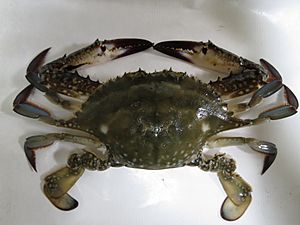Portunus trituberculatus facts for kids
Quick facts for kids Portunus trituberculatus |
|
|---|---|
 |
|
| Scientific classification | |
| Genus: |
Portunus
|
| Species: |
trituberculatus
|
| Synonyms | |
|
Neptunus trituberculatus Miers, 1876 |
|
The gazami crab (also known as Portunus trituberculatus, South Korea's blue crab, or horse crab) is a very popular type of crab. It is the most fished crab species in the world. You can find it living off the coasts of East Asia. It is a close relative of another crab called Portunus armatus.
Contents
Catching Gazami Crabs
The gazami crab is caught more than any other crab species globally. Each year, over 300,000 tonnes of these crabs are caught. A huge 98% of this catch happens off the coast of China. People really like to eat gazami crabs because they are considered very healthy. They are especially valued for their "crab cream," which is the crab's roe or eggs.
Where Gazami Crabs Live
You can find the gazami crab in the waters near several countries. These include Japan, Korea, China, Palau, and Taiwan. They prefer coastal areas where they can find food and shelter.
What Gazami Crabs Look Like
The hard shell on the back of a gazami crab, called its carapace, can grow quite large. It can be up to 15 cm wide. From front to back, the shell can measure about 7 cm.
It can be tricky to tell the gazami crab apart from its close cousin, P. armatus. But there are a few easy ways!
- The gazami crab has three wide teeth on the front edge of its carapace. The P. armatus has four.
- On the inner edge of its legs (a part called the merus), the gazami crab has four teeth. The P. armatus only has three.
Naming the Gazami Crab
The gazami crab was first described by a scientist named Edward J. Miers in 1876. He originally gave it the name Neptunus trituberculatus. Scientists have studied its DNA to learn more about its family history. They found that it separated from the Chinese mitten crab's family tree about 183.5 million years ago. This helps us understand how different crab species have changed over a very long time.
Images for kids


